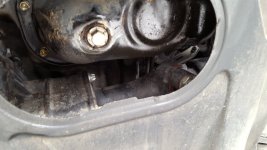OK, it's hot and I'm done beating nails for the day (fixing Pop's oil house ...).
Here's the background. I was alive and wrenching for $$ in a shop in the 1960's. So now you know how old I am ...
We did use ATF to clean engines while the owners drove. But we are talking 1960's oils and the associated sludge they caused. Almost all Group I lubricants ...
ATF worked because it was still made with whale oil as part of the mix. That means it worked just like Auto-RX does now by using polar molecules derived from natural oils which can work their way under sludges. Not under varnish, because it is itself a polar chemistry and it's fried on. Sludges are mostly from reaction with water vapors and cooling (condensates) which is why they are under the valve covers (tin cools) and not in the crankcase (hotter).
Just about the time I started trucking petroleum, the whale oil bans came down and the Japanese stopped selling bulk whale oil. So ATF changed and the all-petro ATF would not clean squat ...
Enter all the magic cleaners and additives. They came out weekly and folks would try anything. Some worked OK, like MMO. Most did nothing. Move forward 40 years and folks are discovering the real ester based synthetic oils do a similar job cleaning, albeit much slower.
So the best approach, if the motor runs OK and does not have valve/lifter noise, is to just use an inexpensive true synthetic oil, and a decent large filter, and do it over time. No odd chemicals. But if you must use an additive, the only ones that I know will absolutely work are BG109 and KREEN.
In you cleaning mix, you want at least 50% ester based oils. So look carefully at what can be gotten for reasonable $$ and use that. Guaranteed that it will not be what the rental company was using. And that's good because you need an alternative chemistry to work with what formed the sludge in the first place

Using this approach, you will have a clean motor in 10,000 miles w/o any stress or damage

And all you have to do is to drive it around at op-temp and change the filter every 1,500 miles and top up with more synthetic. You can leave the oil in for 6,000 miles as long as you change the filter that is getting loaded ... Let the filter do the work

Here's the background. I was alive and wrenching for $$ in a shop in the 1960's. So now you know how old I am ...
We did use ATF to clean engines while the owners drove. But we are talking 1960's oils and the associated sludge they caused. Almost all Group I lubricants ...
ATF worked because it was still made with whale oil as part of the mix. That means it worked just like Auto-RX does now by using polar molecules derived from natural oils which can work their way under sludges. Not under varnish, because it is itself a polar chemistry and it's fried on. Sludges are mostly from reaction with water vapors and cooling (condensates) which is why they are under the valve covers (tin cools) and not in the crankcase (hotter).
Just about the time I started trucking petroleum, the whale oil bans came down and the Japanese stopped selling bulk whale oil. So ATF changed and the all-petro ATF would not clean squat ...
Enter all the magic cleaners and additives. They came out weekly and folks would try anything. Some worked OK, like MMO. Most did nothing. Move forward 40 years and folks are discovering the real ester based synthetic oils do a similar job cleaning, albeit much slower.
So the best approach, if the motor runs OK and does not have valve/lifter noise, is to just use an inexpensive true synthetic oil, and a decent large filter, and do it over time. No odd chemicals. But if you must use an additive, the only ones that I know will absolutely work are BG109 and KREEN.
In you cleaning mix, you want at least 50% ester based oils. So look carefully at what can be gotten for reasonable $$ and use that. Guaranteed that it will not be what the rental company was using. And that's good because you need an alternative chemistry to work with what formed the sludge in the first place

Using this approach, you will have a clean motor in 10,000 miles w/o any stress or damage

And all you have to do is to drive it around at op-temp and change the filter every 1,500 miles and top up with more synthetic. You can leave the oil in for 6,000 miles as long as you change the filter that is getting loaded ... Let the filter do the work



